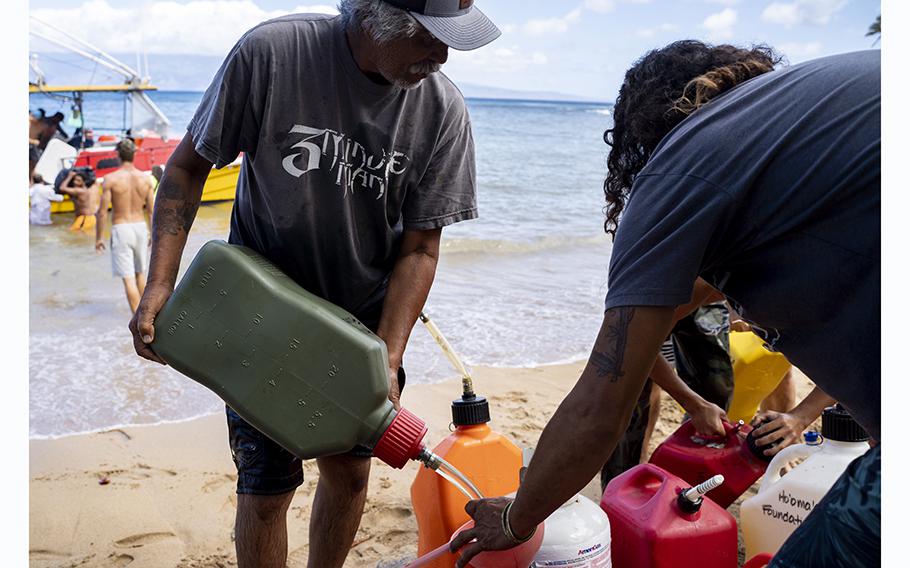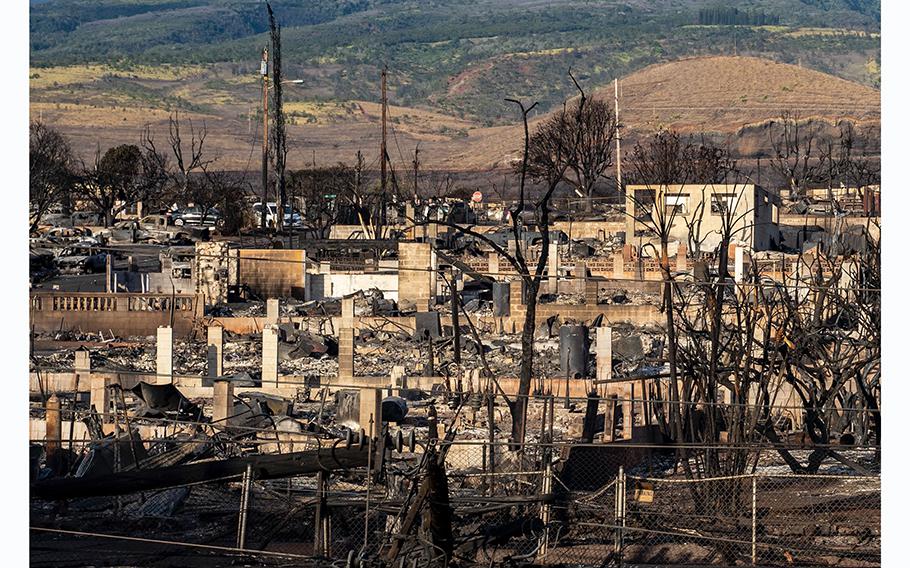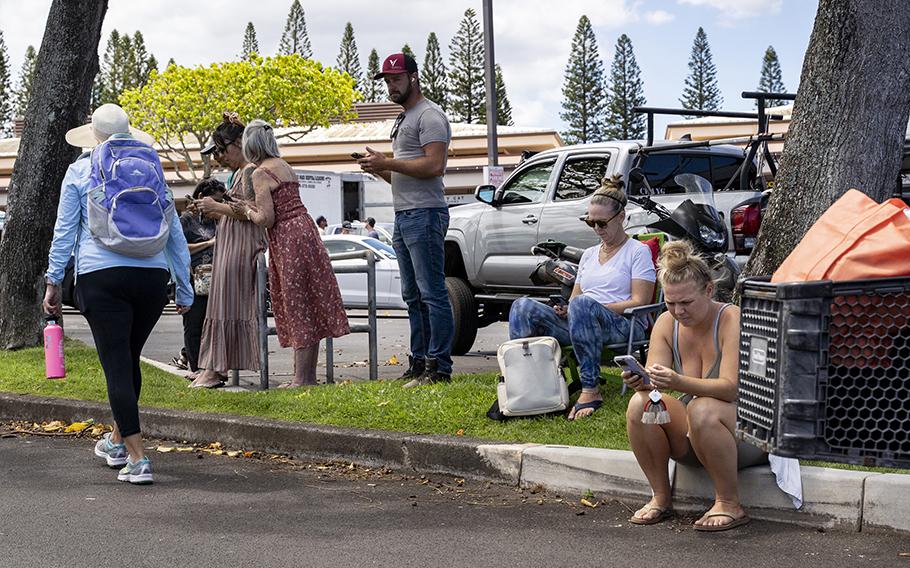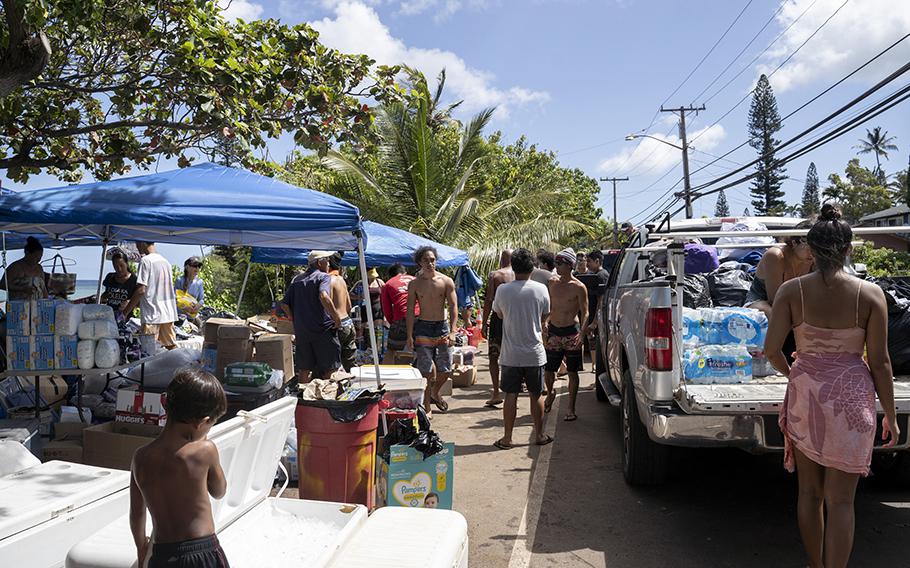
Local residents divide rations of gasoline near where a boat full of supplies was offloaded in the Kahana area of Hawaii, on Friday, Aug. 11, 2023. (Mengshin Lin for The Washington Post)
LAHAINA, Hawaii - The boats kept coming. One by one, cruisers and catamarans eased toward the beach in Kahana, a small and tightknit neighborhood just north of Maui's hardest-hit areas.
Each one was laden with supplies: generators, propane tanks, trash bags full of clothing and ready-to-eat meals. And each one was greeted by two dozen people, the first among them wading waist-deep into the ocean to retrieve provisions from the boat and pass them down the chain, which wound its way to shore.
The entire operation buzzed with urgent efficiency. But this was not the National Guard, or the Federal Emergency Management Agency, nor state or local government. This was scores of residents, led mostly by native Hawaiians, who had battled immense grief and unreliable communications to coordinate a large-scale disaster relief effort serving everyone in need after Tuesday's ruinous Maui fire.
And this, a parade of boats that brought desperate locals thousands of pounds of supplies, was one of many.
"There's no government agency helping us - this is it," said Jareth Lumlung, a native Hawaiian who helped arrange the de facto donation hub. "This is our home, our community."
In the days since a ferocious wildfire decimated whole swaths of Maui, including the historic west island town of Lahaina, those who live here have said they've received little help from the county and state, small entities which are struggling to respond to an unprecedented calamity.
For people whose cultural traditions have been threatened by American colonization and the state's embrace of tourism and development, government help was never expected. Instead, the community has relied on itself.

Officials said most of Lahaina, the historic town in West Maui, was destroyed when hurricane winds pushed fires to the coast. (Mengshin Lin for The Washington Post)
Many, native Hawaiians in particular, see the absence of visible official support as a continuation of long-standing frustrations and pain, which began with the destructive arrival of Europeans and lives on in struggles over water rights.
The displacement of native Hawaiians is a particularly acute concern now, as much of the island has been targeted for gentrification, driving up the costs of living and forcing many native Hawaiians to move to mainland cities like Las Vegas.
Government officials have said they were focused on putting out the flames, housing and feeding survivors in evacuation centers outside the burn zone, protecting damaged areas, clearing roads in and around the town and helping to restore essential utilities. Some of the aid is out of reach of survivors, however, because they lack transportation or working phones to alert them about services. In Lahaina, the private efforts have been more visible, survivors said.
Hawaii Gov. Josh Green (D) estimated that nearly all of Lahaina had been destroyed. But in Kahana, the town's spirit remained completely alive.
"If you take away all Hawaiians, there'll be no more Hawaii," Lumlung said. "It'll be just a place. This is what it's all about right here. We're all raised the same way; this is something that's just naturally instilled. You don't have to be asked to do these things."
The supply boats began arriving on Wednesday, as first responders were still battling the blaze and recovering bodies amid burned-out homes and businesses. Two days later, they hadn't slowed. On Friday, they began arriving early, and volunteers had tents set up to sort the goods: a pile of men's pants here, a pyramid of diapers there and vast mounds of bottled water.
"We lost everything. We lost our town," said Jerica Naki, whose home in Lahaina was destroyed. "That's why we're here."
On this day, the volunteer boats largely came from neighboring islands, Oahu and Molokai, northwest of Maui in the Hawaiian archipelago, traveling far on choppy seas. Naki was helping sort donations and she described an emotional whirlwind, from escaping with nothing to seeing a staggering amount of volunteer support for those who have been displaced like her.
"A lot of us are born and raised here," Naki said, looking around as the chain of volunteers hauled in boxes of tinned sausage. "There's a lot of pride in Lahaina, so it hurts, a lot. But this is all we have here now, each other, and we're making do."

Residents gather at Napili Plaza in Lahaina, Hawaii, to connect to Starlink satellites to contact their loved ones on Friday, Aug. 11, 2023. (Mengshin Lin for The Washington Post)
As the response has worn on, the greatest needs have shifted. There is now plenty of nonperishable food and bottled water. Generators, fuel and Starlink satellite internet systems would be most useful, volunteers say.
Sheryl Nakanelua knew instinctively where she needed to go when she fled her Lahaina home as flames spread. She made her way to Kahana and set up a tent across from Lumlung's house, where she'll stay until her family is let back into her subdivision, one of the few that was spared.
"This is our family place, it's home," she said of the Kahana neighborhood. "This is the best part to be at. It's what's keeping us positive."
Other such spots have popped up. Napili Plaza, once a destination for groceries, ribs and tattoos, is now a donation drop-off center. And some 100 cars lined up for free gas near the town's former railroad station. Coordinating the boats and other donation sites is a massive task that involves maddening games of phone tag in a place largely without cell service and requires a relentless dedication and extensive Rolodex.
Residents like Zane Schweitzer have both. Schweitzer, whose family has lived around Lahaina for generations, has spent nearly every hour of the last 48 working his walkie-talkie and phone, frantically arranging aid from around Maui, Hawaii and the mainland. Working with the Oahu-based youth nonprofit Na Kama Kai, he helped coordinate one of Friday's largest deliveries.
On the south side of Lahaina, in Olowalu, Eddy and Sam Garcia are transforming their groundbreaking sustainable farm into a shelter for those who have lost their homes. The married couple, who themselves have lost farmland and fruit crops worth hundreds of thousands of dollars, are setting up temporary housing, a massive solar power system and a satellite internet connection that they'll open to anyone who needs it.
"In the immediate moment, people need shelter, they need food, they need water, they need a place to get on the internet so they can look for their loved ones," said Eddy Garcia, who grew up in Lahaina. "We're shifting all of our attention to trying to feed and house our neighbors."

Local residents gather to distribute supplies to those in need after the Maui fire in the Kahana community of Hawaii on Friday, Aug. 11, 2023. (Mengshin Lin for The Washington Post)
The Olowalu farm is uniquely well-prepared to handle this sort of disaster. Run by the Garcias' nonprofit, Regenerative Education Centers, it was already operating off the grid, with its own power, plumbing and food. The nonprofit has launched a fundraiser to help pay for the fire effort, which will continue as long as there's a need.
The property, even after being raked by the fire's severe winds, is verdant and shaded by tall mango trees. On Friday, volunteers and staff readied the farm to fill any needs. They butchered and smoked a wild pig, set up new solar panels and scoured the internet for portable toilets. Eddy Garcia whirred with adrenaline, his satellite-connected cellphone ringing every few minutes with someone offering help.
For locals like him, helping his neighbors is not only about their survival, but about preserving the island's identity and keeping it livable for those whose families have been here for generations.
"It's not about these giant hotels on the beach and all the big companies, but trying to take care of local people," he said. "This is not a visitor's destination spot, this is the kingdom of Hawaii. That hit the heart of it in Lahaina. It hurts to even talk about it."
His phone rang again and he stood up to leave.
"I'm like a ball of rubber bands right now," he said, "and the only thing keeping me going is I got to organize these things."